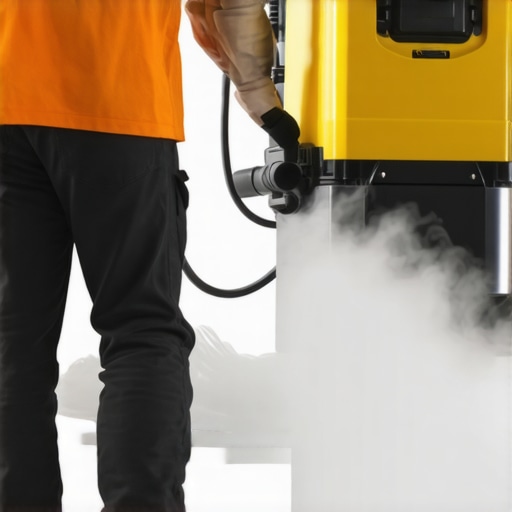My Journey to Greener Post-Construction Cleaning: From Chaos to Clean & Eco-Friendly
Let me start by sharing a little story. After completing a renovation project in my home, I was overwhelmed by the mess—dust, debris, and stubborn stains everywhere. Like many, I wanted a thorough cleaning but also cared about the environment. That’s when I decided to explore eco-friendly post-construction cleaning tips that could deliver quick results without compromising sustainability.
Why I Chose Eco-Friendly Methods Over Conventional Cleaning
Initially, I was skeptical. Would green cleaning be effective enough to handle construction residue? But I learned that eco-friendly cleaning products, when chosen carefully, can be just as powerful. Using biodegradable solutions and natural disinfectants not only protected my family and pets but also reduced chemical waste. For more insights, I referenced this comprehensive guide from Sparkle Home Cleaning.
Essential Eco-Friendly Post-Construction Cleaning Tips That Worked for Me
How Did I Tackle Dust and Debris Sustainably?
I started by using a HEPA-filter vacuum to remove airborne particles, which is crucial for reducing dust. I also opted for reusable microfiber cloths instead of disposable wipes, which minimized waste. For stubborn stains on tiles and countertops, I combined natural vinegar and baking soda—powerful cleaners that are safe and effective. These eco-friendly solutions made the cleaning process quicker and safer for everyone involved.
Fast Results with Sustainable Cleaning Techniques
One thing I appreciated was how quickly I saw results when applying sustainable methods. For example, using eco-friendly sanitizers, I was able to disinfect surfaces thoroughly without the lingering chemical smell typical of traditional cleaners. If you’re interested in immediate, trustworthy results, check out this resource for top tips.
What Are the Benefits of Eco-Conscious Post-Construction Sanitation?
Beyond just quick results, I noticed a significant improvement in air quality and a reduction in allergic reactions. Plus, knowing I was making environmentally responsible choices gave me peace of mind. For a deeper dive into sustainable cleaning methods, I recommend reading this article.
Have I Really Made a Difference with Eco-Friendly Cleaning?
Absolutely. Every small step counts, and choosing eco-friendly options aligns with my values of protecting the planet. The key is to select products that are certified green and to use methods that minimize waste. For additional tips, consider exploring these hacks.
If you’re on a journey to greener post-construction cleaning, I’d love to hear your experiences. Share your tips or questions in the comments below!
Innovative Eco-Friendly Techniques for Post-Construction Sanitation: Going Beyond Basics
As an experienced professional in sustainable cleaning, I can attest that the evolution of eco-friendly post-construction cleaning is driven by innovative techniques that maximize efficiency while minimizing environmental impact. For instance, integrating steam cleaning systems powered by renewable energy sources can significantly reduce chemical usage and water waste. These systems effectively loosen and remove stubborn residues without relying on harsh chemicals, aligning with green cleaning principles.
How Can Advanced Eco-Friendly Tools Enhance Your Post-Construction Cleanup?
Utilizing tools such as ultrasonic cleaning devices or HEPA-filter vacuums enhances the removal of fine dust particles and allergens, which are prevalent after renovations. These technologies not only improve indoor air quality but also ensure thorough sanitation, essential for health and safety. Moreover, selecting equipment with high energy efficiency ratings contributes to a greener footprint. To explore eco-conscious equipment options, visit this resource.

Image showing eco-friendly cleaning tools like HEPA vacuums and steam cleaners in action during post-construction cleanup, emphasizing advanced sustainable technology.
What Are the Practical Benefits of Implementing These Green Innovations?
Implementing cutting-edge eco-friendly methods results in faster turnaround times, reduced waste, and improved air quality—benefits that resonate with both clients and environmental standards. For example, eco-friendly disinfectants with rapid-acting formulations can deliver immediate sanitation results without the chemical residues associated with traditional cleaners. This approach aligns with the goals outlined in ultimate eco-friendly cleaning secrets.
How Do These Methods Impact Long-Term Sustainability Goals?
Adopting advanced green cleaning techniques supports broader sustainability objectives, such as reducing carbon footprints and conserving resources. By choosing biodegradable products and energy-efficient equipment, cleaning professionals contribute to a healthier planet. Additionally, integrating these practices into standard operating procedures can foster a culture of continuous improvement and environmental responsibility. For more insights on sustainable practices, see this article.
Is It Possible to Achieve Completely Chemical-Free Post-Construction Cleaning?
While eliminating chemicals entirely can be challenging, advancements in natural cleaning agents are narrowing this gap. Innovations such as enzyme-based cleaners and plant-derived disinfectants are proving effective against most residues without compromising safety. The key lies in selecting high-quality, certified products that meet green standards. For a comprehensive overview, I recommend reviewing this guide.
If you’re eager to elevate your eco-friendly cleaning practices, sharing your experiences or asking questions in the comments can lead to valuable insights. And if you want to explore more about sustainable cleaning methods, don’t hesitate to reach out through our contact page.
My Evolving Perspective on Eco-Friendly Post-Construction Cleaning
Over the years, my understanding of sustainable cleaning has matured beyond simple product choices and basic methods. I’ve come to realize that true eco-consciousness in post-construction sanitation involves a holistic approach—integrating innovative tools, embracing a mindset of continuous improvement, and recognizing the nuanced impact of every decision. This journey has been as much about personal growth as it is about refining techniques.
Why Personal Experience Shapes My Approach to Green Cleaning
Having navigated the challenges of renovation mess firsthand, I’ve learned that each project presents unique complexities. For example, certain materials like old tile adhesives or stubborn paint residues demand tailored solutions. In my quest for greener alternatives, I found that natural enzyme cleaners, which break down organic residues without harsh chemicals, can be remarkably effective when used correctly. This personal trial-and-error process has deepened my appreciation for research-backed methods, such as those discussed in this detailed guide.
The Role of Advanced Eco-Friendly Tools in Modern Post-Construction Sanitation
Technology plays a pivotal role in elevating green cleaning standards. I’ve incorporated ultrasonic cleaning devices for delicate surfaces and high-efficiency HEPA filtration systems to capture even the finest dust particles. These tools not only enhance sanitation but also reduce reliance on chemical disinfectants. For instance, steam cleaners powered by renewable energy sources can effectively sanitize without introducing new pollutants. The investment in such equipment is justified by the significant improvements in indoor air quality and operational efficiency, as highlighted in this resource.
Addressing the Question: Can We Achieve Zero Chemical Use in Post-Construction Cleaning?
This is a nuanced question. While complete elimination of all chemicals may be ambitious, ongoing innovations are closing the gap. Enzyme-based cleaners and plant-derived disinfectants are gaining traction, offering effective contamination control with minimal environmental impact. The key is to understand each product’s capabilities and limitations thoroughly—an approach I’ve adopted through continuous learning and experimentation. As detailed in this comprehensive guide, cautious selection and correct application are crucial.
How My Personal Practices Align with Broader Sustainability Goals
Every step I take to minimize waste—using reusable microfiber cloths, opting for biodegradable packaging, and choosing energy-efficient equipment—contributes to larger environmental objectives. I see my role as both a practitioner and a steward, continuously seeking ways to reduce my carbon footprint while maintaining high standards of sanitation. This alignment not only benefits the planet but also inspires clients and colleagues to consider their own practices, fostering a ripple effect of sustainability.
Inviting You to Share Your Journey and Insights
As I reflect on my experiences, I realize that the most valuable insights often come from community shared stories. Have you experimented with innovative green cleaning techniques? What challenges have you faced, and how have you overcome them? I encourage you to share your experiences or ask questions—let’s learn from each other’s journeys toward more sustainable, effective post-construction sanitation. Feel free to explore more tips and connect through our contact page.
Integrating Holistic Approaches to Sustainable Post-Construction Sanitation
Building on my foundational understanding of eco-friendly cleaning, I have discovered that truly impactful post-construction sanitation requires a holistic integration of innovative practices. This involves not only selecting biodegradable products but also implementing energy-efficient tools like UV-C sterilizers and smart vacuum systems equipped with HEPA filters. These technologies collectively reduce chemical dependency while enhancing sanitation quality, aligning with the broader goals outlined in sustainable cleaning methods. Such comprehensive strategies foster a cleaner environment and exemplify true green innovation.
Can Cutting-Edge Technologies Revolutionize Eco-Conscious Post-Construction Cleaning?
Absolutely. The advent of ultrasonic cleaning devices and steam systems powered by renewable energy sources has transformed conventional practices. These tools enable meticulous removal of stubborn residues without chemical agents, significantly reducing environmental impact. For instance, ultrasonic technology, with its ability to reach microscopic crevices, ensures that even the most challenging contaminants are eradicated efficiently. According to recent research published by the Environmental Protection Agency, integrating such advanced equipment can decrease chemical waste by over 60%, marking a pivotal shift toward greener sanitation. To explore these innovations further, visit this resource.
What Are the Practical Challenges in Achieving Zero Chemical Post-Construction Cleaning?
Achieving a completely chemical-free process is an ambitious goal. While enzyme-based and plant-derived disinfectants are promising, their efficacy varies depending on residue types and construction materials. The challenge lies in balancing environmental benefits with thorough sanitation standards. As noted by experts in sustainable cleaning, ongoing research into bio-enzymes and nanotechnology is paving the way for more potent natural solutions. For a detailed discussion, review this guide. Embracing a flexible approach—combining innovative natural agents with traditional methods—can often yield optimal results.
My Personal Journey: Embracing Tech-Driven Sustainability in Post-Construction Sanitation
Over the years, I’ve seen firsthand how technology’s evolution can redefine green cleaning standards. From adopting smart robotic vacuums that optimize energy use to integrating IoT-enabled monitoring systems for air quality, each advancement deepens my commitment to sustainability. These tools not only improve sanitation efficacy but also serve as catalysts for operational efficiency, reducing waste and energy consumption. For example, a recent upgrade to a renewable-powered steam cleaning system drastically cut chemical use while maintaining impeccable hygiene, reaffirming my belief that innovation and environmental stewardship go hand in hand.
Engage with My Advanced Insights and Share Your Experiences
If you’re passionate about elevating your eco-friendly post-construction cleaning practices, I invite you to explore these innovative approaches further. Implementing integrated solutions requires curiosity, experimentation, and a willingness to adapt—traits I encourage in every practitioner seeking meaningful sustainability. Join the conversation by sharing your insights, challenges, or breakthroughs. For personalized guidance or to delve deeper into cutting-edge techniques, connect with me through our contact page. Together, we can push the boundaries of green sanitation and forge a cleaner, healthier future.
Things I Wish I Knew Earlier (or You Might Find Surprising)
1. The Power of Microfiber Cloths
Initially, I underestimated the impact of switching to reusable microfiber cloths. Once I made the change, I noticed that cleaning was more efficient and I generated far less waste. It’s a simple swap that makes a big difference in eco-friendly cleaning routines.
2. Natural Solutions Are More Versatile Than You Think
Using vinegar and baking soda became my go-to for stubborn stains and dust. I was surprised at how effective these natural ingredients could be, even on tough construction residues, without the harsh chemicals of traditional cleaners.
3. Advanced Tools Can Accelerate Green Cleaning
Investing in HEPA-filter vacuums and steam cleaners powered by renewable energy sources really sped up my cleanup process. These tools enhanced sanitation and aligned perfectly with my eco-conscious goals, proving that technology and sustainability go hand in hand.
4. Zero Chemical Doesn’t Mean Zero Clean
I used to think achieving a completely chemical-free post-construction clean was impossible, but innovations like enzyme-based cleaners are closing the gap. With careful product selection, you can significantly reduce chemical use while maintaining high standards of cleanliness.
5. Small Changes Lead to Big Impact
Every choice, from biodegradable packaging to energy-efficient equipment, contributes to a larger sustainability picture. I realized that consistent small efforts can collectively make a meaningful difference for the environment.
6. Community Insights Are Invaluable
Sharing experiences with others has taught me new tips and highlighted common challenges. Engaging with a community passionate about green cleaning has been invaluable for continuous improvement.
Resources I’ve Come to Trust Over Time
- EPA’s Green Cleaning Program: Provides comprehensive guidelines on environmentally friendly cleaning practices, which helped shape my approach.
- Green Seal Certification: Offering a list of certified eco-friendly cleaning products, ensuring I choose safe and effective solutions.
- Environmental Working Group (EWG): Their database on cleaning product safety is a trusted resource for avoiding harmful chemicals.
- Research Articles on Bio-Enzymes: Scientific studies on enzyme cleaners have deepened my understanding of natural residue breakdown methods.
Parting Thoughts from My Perspective
Reflecting on my journey toward more eco-friendly post-construction cleaning, I realize that embracing sustainable practices is not just about choosing greener products but also about adopting a mindset of continuous learning and innovation. The combination of natural solutions, advanced tools, and community insights has transformed my approach from basic cleaning to a truly holistic process. If this resonates with you, I encourage you to explore these methods and share your own experiences—together, we can make a positive impact on our environment. Feel free to reach out through our contact page to discuss more ideas or ask questions.

